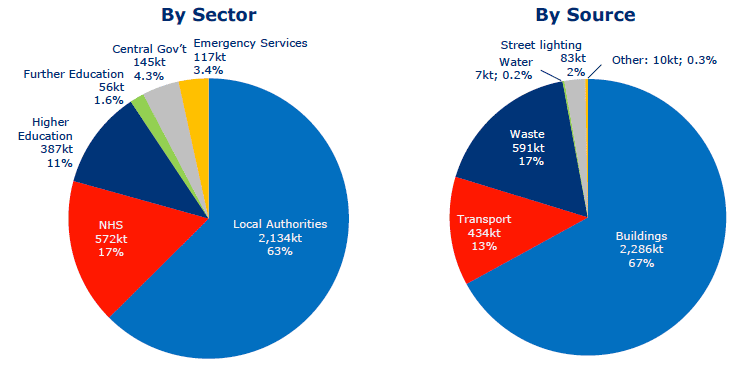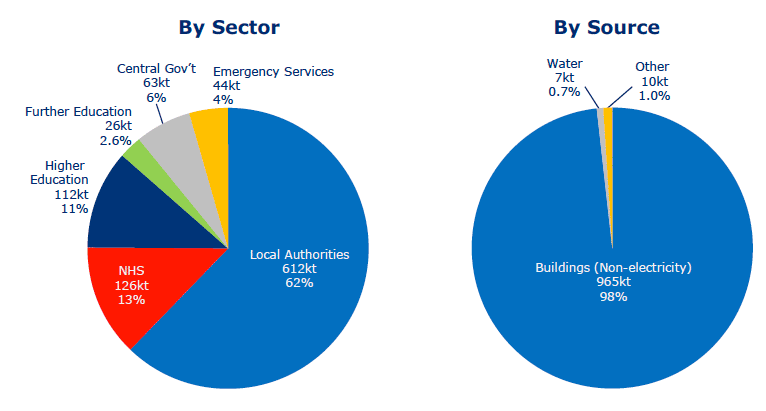Potential carbon abatement from the Scottish public sector: summary report
As part of the RPP2 process, we commissioned the Carbon Trust to estimate the carbon abatement potential of the Scottish public sector to 2030.
3 Public Sector Emissions Baseline
Method
To inform and sense-check the estimate of abatement potential, an emissions baseline was developed by aggregating the baseline information from the Carbon Management Plans ( CMPs) of 138 public sector bodies ( PSBs)that were available. The 138 organisations included represent c. 80% of the total PSBs in Scotland by number and we estimate around 90-95% by volume of emissions. CMPs were available for all 32 Local Authorities and all 19 emergency services, with coverage of between 65% and 79% by number of organisations across other sectors of the public sector.
The majority of CMPs are 5 or 6 year plans (100 of the 138) with a small number taking a longer term (10 yr) view. All plans have a baseline year against which their carbon reduction targets are set, and in the majority (over 60%) of CMPs the baseline year was either 2008 or 2009.
As a result there is very little explicit coverage beyond 2015 in CMPs. The carbon reduction targets in CMPs - which are defined by the PSB itself - vary from 10% reduction over 5 years to 50% over 5 years, with an average close to 20% (weighted by emissions) in each sector.
The 'Combined' Emissions Baseline
The 'Combined' baseline includes all emissions reported in CMPs, both traded and non-traded and including in many cases emissions from waste and transport. Total 'Combined' emissions from the public sector are estimated to be 3.4 million tonnes of CO 2 (MtCO 2) per annum. The charts in Figure 1 show the breakdown by sector and by source.
Local Authorities account for two thirds of the emissions baseline, and together with NHS and Higher Education account for over 90% of the total baseline. From an emissions source perspective, buildings account for over two thirds of the total emissions baseline, and for most sectors account for 80-90% of emissions. The exceptions are Local Authorities, where waste accounts for 26% of emissions (Local Authorities account for 94% of waste emissions from the whole public sector) and Emergency Services where transport accounts for 24% of emissions.
Figure 1: Combined Emissions Baseline (Total 3,411 ktCO2)

Source: Carbon Trust analysis of 138 Carbon Management Plans
The ' RPP2' Emissions Baseline
To be consistent with the RPP2 process, where traded emissions, transport and waste are covered separately, it was necessary to produce a baseline excluding those items. This baseline is referred to in this document (and the accompanying PowerPoint version) as the ' RPP2' baseline to distinguish it from the 'Combined' baseline that includes all sources. To calculate the RPP2 baseline the portion of buildings emissions derived from electricity (because this is traded) was estimated using the energy consumption data in the CMPs (49% of buildings emissions derive from electricity) and excluded, along with transport and waste (which are reported separately in CMPs). Excluding these items reduces the baseline to 0.98 MtCO 2. Figure 2 shows the breakdown of the RPP2 baseline by sector and source.
The sector breakdown of the RPP2 baseline is similar to that of the Combined baseline, with Local Authorities accounting for over 60% of the total. The breakdown by source is very different, due to the exclusion of the transport and waste categories. Buildings (on-site consumption of fossil fuels) account for 98% of emissions in the RPP2 baseline.
Analysis of the make-up of the RPP2 baseline by organisation reveals that the 5 largest PSBs account for 20% of the RPP2 baseline, and the largest 17 account for 50%.
Figure 2: ' RPP2' Emissions Baseline (Total 983 ktCO2)

Source: Carbon Trust analysis of 138 Carbon Management Plans
Contact
There is a problem
Thanks for your feedback